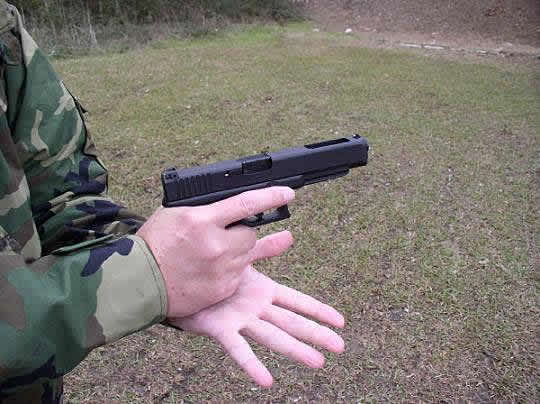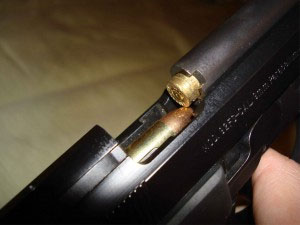Stay Calm and Keep Shooting: Clearing Malfunctions
Cheaper Than Dirt! 11.09.12

If you shoot a semi-automatic rifle or pistol, it is inevitable at some point you will have a malfunction. This is when you pull the trigger and nothing happens. Well, something happens, but it isn’t what you expect. The gun doesn’t go bang. Many people call this a “jam,” but the correct term is malfunction. Most malfunctions you can fix yourself. The problem turns into a jam when you cannot clear the issue and need the service of a gunsmith.
Malfunctions are caused by a problem with the ammunition; the mechanics of the gun or the shooter. To get the most out of your training, familiarize yourself with the types of malfunctions and how to fix them. To do this you will need to be able to perform these actions quickly in a self-defense situation.
Your first fix for most malfunctions is the “tap-rack-bang.”
- Tap — slam the bottom of the magazine with the palm of your hand to make sure it has seated properly.
- Rack — rack the slide a few times to clear the chamber and load a new round.
- Bang — pull the trigger.
Squib
A squib is a round that does not have enough powder charge to send the bullet down the chamber and out of the barrel. Therefore the bullet gets stuck in the barrel. A squib can be a danger to you and your firearm. It is important to be aware of what happens after you pull the trigger. A squib will only go “pop” as opposed to “bang”and you will most likely feel less recoil than normal. If you do not notice the squib, you might be able to load another round. This can really damage your gun. If you suspect you have a squib, stop shooting. Clear the action, make your gun safe, and check the barrel. Squibs occur most commonly with handloads, but factory ammunition can produce a squib round as well. Clearing a squib with tap-rack-bang is not possible. You may be able to remove the bullet with a barrel cleaning rod, however if you are unsure, take your gun to a gunsmith or call the range officer to remove the bullet.
Failure to Feed
A failure to feed is when a cartridge will not load into the chamber. A round that fails to feed is normally associated with a magazine problem — the spring needs cleaning or possibly it’s a bad follower. It is possible that the magazine was not inserted properly. In my experience, a little lubrication on the feed lips of the magazine and in the chamber fixes this issue. After checking to see if your magazines are in good working order, your next step would be to switch ammo. Some guns are finicky.
 Failure to Eject
Failure to Eject
A failure to eject means the case has not come out of the chamber after the guns fires.
A failure to eject problem may also be called a stovepipe.
This is when the case gets stuck standing up, preventing the slide from returning to battery. To fix a failure to eject, use tap-rack-bang, but first roll your gun 90 degrees to the right. This will allow gravity to aid your efforts in removing the case. The experts at Magpul teach students to swipe at the stuck round with your hand to remove it.
Hangfire
A hangfire is a delay between the time the firing pin hitting the bullet’s primer and the round going off. Keep your gun pointed in a safe direction for at least 30 seconds to see if the round goes off. After that — with the gun pointed in a safe direction — rack the slide to eject the malfunctioning round. Do not pick it up after ejection.
Slamfire
A slamfire is when a new round loads into the chamber and the bolt return causes the firing pin to hit the primer hard enough to cause the round to fire without the trigger having to be engaged.
Double Feed
You have a double feed when two live rounds attempt to feed into the chamber. To fix a double feed, first remove the magazine. Then, rack the slide to eject both rounds. Once both rounds have been ejected, insert a fresh magazine, and you should be ready to rock and roll.
You have a double feed when two live rounds attempt to feed into the chamber.
Short Stroke
A short stroke is when the gun does not complete a full cycle after a round has fired. The round will successfully leave the barrel, however, the slide did not go all the way back and the gun will not load a new round. There is usually no indication that a short stroke has happened.
Misfire
A misfire is when you pull the trigger and the gun goes “click”. A misfire is normally due to a faulty primer. It may also be an issue with the gun’s firing pin. If tap-rack-bang does not correct the issue, remove the bad round and dispose of it safely.
There are two common shooter issues that may also cause a malfunction. One is being too gentle when you rack the slide. This was my problem as a noob and causing persistent issues with getting a round to chamber, known as failure to feed. Another shooter problem is when you do not have a firm grasp on your gun, this is called limpwristing and may cause any of the previous problems.
You will also see malfunctions labeled Level I, Level II and Level III. A Level I malfunction is the easiest to clear, for example a misfire is a Level I malfunction. Level II is a failure to eject, like a stovepipe. A Level III malfunction is a failure to extract or a double feed.
It is important to practice clearing malfunctions and learning to perform it quickly — especially in your self-defense gun. You can safely use snap caps to practice. Caleb Giddings’ video and blog demonstrates the importance of thinking and clearing malfunctions quickly.
What is the worst malfunction you have encountered? Tell us in the comments section.
For more helpful tips, visit www.cheaperthandirt.com.



